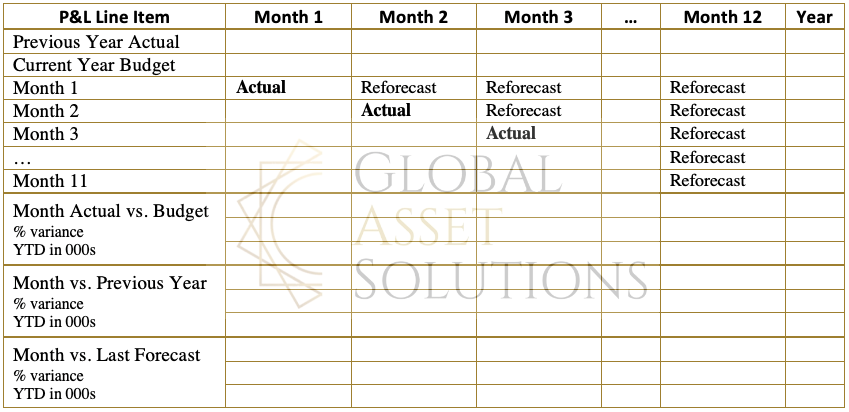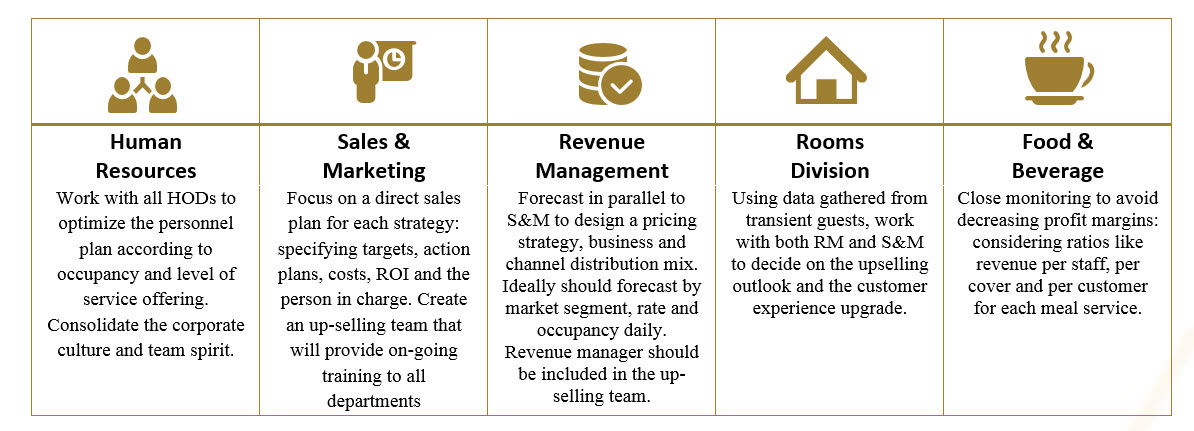
With the advent of the ‘new normal’, hotel owners and operators must begin considering the various financial and operational scenarios in their forecasts extending into 2021. Accurate forecasting is notoriously tricky, even in “business as usual” times. Often, some operators need more pressure to deliver detailed breakdown forecasts and they rarely extend more than three months in the future. The objective of a forecast plan is to ask the hotel operator to propose tangible actions: to increase the performance of specific areas of the hotel, to manage the production of the personnel, to schedule productive activities and to increase customer satisfaction.
In this article, we aim to navigate the key points for asset managers to consider when reviewing forecasts and what you should be asking from your management team. We will also present a sample of the best-in-class forecasting matrix we use at Global Asset Solutions.
1. Data
The concept of data being the ‘oil of the digital age’ is also applicable for hotel asset management. It is essential to track, include and consider previous budgeted and actual numbers. It is the industry standard only to compare the proposed budget for the last two years. At Global Asset Solutions, we look five years into the past to get the best overview of trends. Now, more than ever, you need to consider as many years of data as possible, to be able to base forecasts on other periods of low occupancies. Of course, it is not enough to simply include the numbers; additional details explaining exceptionally high or low figures are crucial for insight. For newer hotels, placing more weight on data from the year of the hotel’s original opening could be beneficial to forecast for the ramp-up expected to extend into 2021.
Along with historical data, forecasting requires knowledge of any future events that could impact the hotel’s performance. Some of this knowledge is internal, such as the arrival of any groups, but the majority is macroeconomic and must be gathered from external sources. PACE reports need to be combined with information from a Radar Report (please refer to our case study here on the summer room pricing outlook in London and Paris) and STR. You should also ask your S&M Manager to provide market occupancies and ADR every month and get their opinion on where they think the market is heading compared to the hotel’s performance. All in all, the more information you can gather, the more accurate your forecasts will be.
Forecasting often focuses on upcoming months till the end of the year. Proper forecasting consists of producing a detailed rolling 12-month P&L, from June 2020 to June 2021, for instance. Furthermore, a more professional forecast should also include the following reports:
- P&L Variance Report: Forecast, current year (actual and re-forecast) and previous year.
- Labour, FTE & headcount report (for each position and by month, with variance from previous years).
- Cash flow statements and detailed forecast of owner expenses.
2. Tracking 12-month P&L forecasts
Most operators only forecast for three months in advance; however, at Global Asset Solutions, we prompt operators to develop accurate 12-month P&L forecasts (ideally rolling twelve-month) that are re-forecasted monthly. Over our years of experience, we’ve developed a matrix to combine all historical data into an accessible view to allow for accurate forecasts and re-forecasts. Below you can find a sample considering two years of data. A table like the one below should be created for each P&L line item, as well as for indicators such as Rooms Expenses POR and F&B Expenses per Customer.
Use of this matrix allows you to evaluate the operator’s re-forecasting capability and better planning of expenses, including staff level. During this ramp-up period, asset managers need to ensure that all efforts are made to re-integrate minimal personnel level, and only as needed. The aim is to ensure we minimize the use of available cash. The matrix is an effective tool to balance expected occupancies with staffing. We also recommend asking the operator to prepare a weekly HR report (FTE’s/payroll versus demand – room/covers/treatment). It is crucial to monitor this most considerable expense closely until full reopening (using re-forecasts versus latest pick-up from both rooms and F&B reservations). You also need to closely track what’s happening in HR in terms of payroll to optimize the hotel revenue per employee. It is best to build your matrix to separate HR line items and then further split these items by management or hourly payroll. It will be too late if asset managers wait for the release of June or July P&Ls to find high salary costs.
A table like ours gives the head of department (HOD) greater control over their budget, since they won’t only focus on the present. As F&B often has low-profit margins, we recommended that the F&B manager tracks each outlet’s profitability daily. In a normal situation, it might sound like micro-managing, but currently it is a must. Furthermore, once the tools and habits are in place, the hotel will benefit in the long term.
3. Analysing the right ratios
Forecasting is most efficient when the right ratios are used to benchmark against past performance. As you know, the basic ratios in use to monitor the hotel operations and financial performance are assigned in three categories: POR (for operational departments), PAR (for expenses unaffected by occupancy) and % Revenue (all departments to measure profitability and margins). In terms of the overall business, the GOPPAR is relevant, because it includes every operational department result providing a holistic view of the hotel performance.
Ratios used less often, but still necessary to evaluate the impact of commissions and S&M cost in the rooms department, are:
- Net ADR (or Net Rooms Revenue): deducts the relevant costs of sales relating to third-party commissions of distribution channels (Travel Agencies’ and Groups’ commissions, Reservations and Group Rooms Control Recovery).
- Triple Net ADR: also deducts the total S&M expenses (except S&M expenses related to other departments like F&B).
As covered earlier, forecasting exactly how much staff will be needed and the resulting payroll is more critical than ever during the expected ramp-up. It is effective to break down the operational departments’ revenue forecast, total payroll and GOP per FTE, optimally by outlet. The objective is to find the exact number of employees necessary based on which services will be offered and when.
4. Liquidity micro-management
As funds are limited, asset managers must adopt more micro-management practices to ensure that cash is only spent where it makes the most impact. Liquidity management should follow suit of practices adopted when working with a hotel’s pre-opening budget. For example, an industry best practice includes restricting the operator’s access to the full amount of agreed-upon operation cash injection. Instead, distributing a predetermined amount to the operator monthly helps to ensure the operator stays within the agreed amount and allows better cash flow monitoring.
As this cash injection is coming from ownership, it is the asset manager’s responsibility to monitor that it is spent well. We recommend the asset manager to approve every single payment made to suppliers week by week. This also allows the identification of providers that need to be eliminated in the future (i.e. temp personnel resources, Third Party training solutions). Asset managers should review all major contracts which can be renegotiated (e.g., dry cleaning, laundry) and those that don’t impact the operation directly (e.g. energy, PR agencies, local OTA commissions). We also recommend simplifying suppliers for the kitchens. All of this can provide significant immediate savings.
5. Capex forecasts
The Capex forecast report should be divided by department. Every project should include a description, the expected cost and the reasons to support the potential investment. Any projects undertaken at this time must have a strong justification and evidence that it either cannot be delayed or would lead to high returns quickly. As explored in 4), liquidity management, micromanagement and increased scrutiny are needed when evaluating planned investments that should impact the bottom line.
6. Comp set surveillance
It is crucial to keep an eye on your comp set weekly and, ideally, by market segment. Your team needs to know when they are opening, what facilities they will have available and what restrictions they have in place; all might have an impact on your forecast.
7. Involvement of all departments
It is essential to involve every department; staff at all levels needs to find opportunities to drive up the hotel value. Therefore, communication between the asset manager and the operator should be transparent. The asset manager must clearly explain the forecasted situation to all HODs so they fully understand the challenges ahead. Some situations might require the asset manager to step in and provide straightforward directions and the KPIs to achieve.



